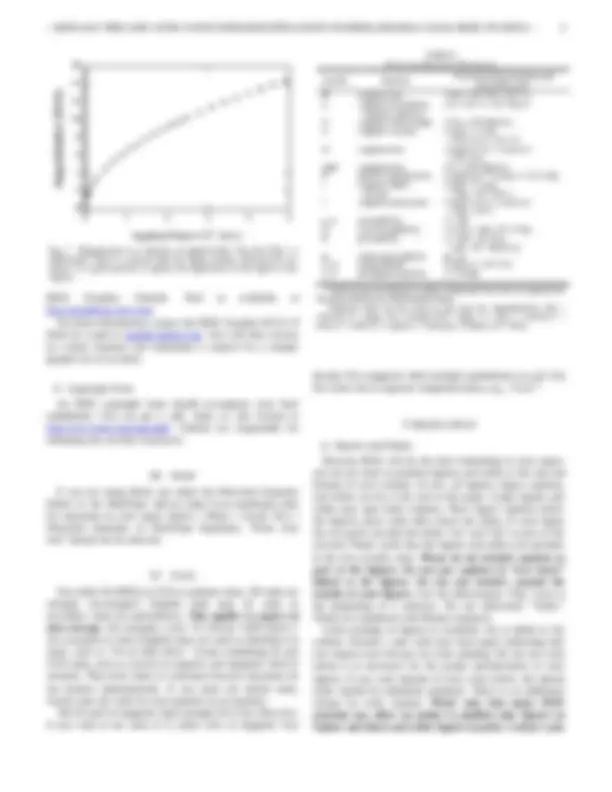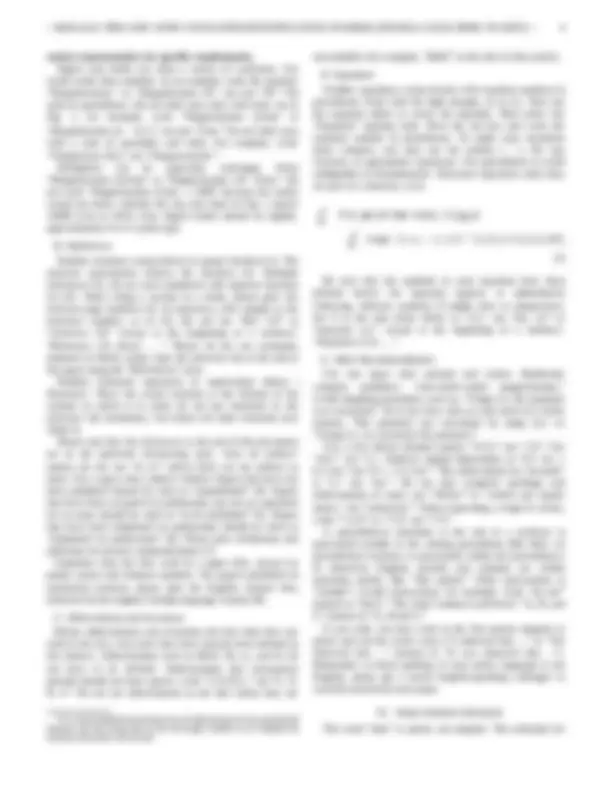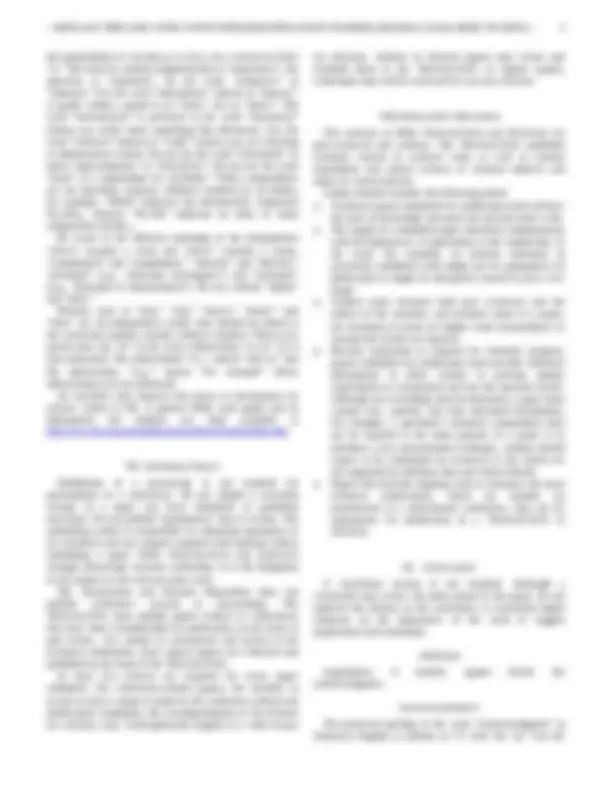





Study with the several resources on Docsity

Earn points by helping other students or get them with a premium plan


Prepare for your exams
Study with the several resources on Docsity

Earn points to download
Earn points by helping other students or get them with a premium plan
Community
Ask the community for help and clear up your study doubts
Discover the best universities in your country according to Docsity users
Free resources
Download our free guides on studying techniques, anxiety management strategies, and thesis advice from Docsity tutors
Material Type: Paper; Professor: Tappert; Class: Capstone Project; Subject: Internet Technology; University: Pace University-New York; Term: Fall 2001;
Typology: Papers
1 / 6

This page cannot be seen from the preview
Don't miss anything!




Abstract —These instructions give you guidelines for preparing papers for IEEE TRANSACTIONS and JOURNALS****. Use this document as a template if you are using Microsoft Word 6.0 or later. Otherwise, use this document as an instruction set. The electronic file of your paper will be formatted further at IEEE. Define all symbols used in the abstract. Do not cite references in the abstract. Do not delete the blank line immediately above the abstract; it sets the footnote at the bottom of this column. Index Terms —About four key words or phrases in alphabetical order, separated by commas. For a list of suggested keywords, send a blank e-mail to keywords@ieee.org or visit http://www.ieee.org/organizations/pubs/ani_prod/keywrd98.txt I. INTRODUCTION HIS document is a template for Microsoft Word versions 6.0 or later. If you are reading a paper or PDF version of this document, please download the electronic file, TRANS-JOUR.DOC, from the IEEE Web site at http://www.ieee.org/web/publications/authors/transjnl/index.html so you can use it to prepare your manuscript. If you would prefer to use LATEX, download IEEE’s LATEX style and sample files from the same Web page. Use these LATEX files for formatting, but please follow the instructions in TRANS-JOUR.DOC or TRANS-JOUR.PDF.
If your paper is intended for a conference, please contact your conference editor concerning acceptable word processor formats for your particular conference. When you open TRANS-JOUR.DOC, select “Page Layout” from the “View” menu in the menu bar (View | Page Layout), which allows you to see the footnotes. Then, type over sections of TRANS-JOUR.DOC or cut and paste from another document and use markup styles. The pull-down Manuscript received October 9, 2001. (Write the date on which you submitted your paper for review.) This work was supported in part by the U.S. Department of Commerce under Grant BS123456 (sponsor and financial support acknowledgment goes here). Paper titles should be written in uppercase and lowercase letters, not all uppercase. Avoid writing long formulas with subscripts in the title; short formulas that identify the elements are fine (e.g., "Nd–Fe–B"). Do not write “(Invited)” in the title. Full names of authors are preferred in the author field, but are not required. Put a space between authors’ initials. F. A. Author is with the National Institute of Standards and Technology, Boulder, CO 80305 USA (corresponding author to provide phone: 303-555- 5555; fax: 303-555-5555; e-mail: author@ boulder.nist.gov). S. B. Author, Jr., was with Rice University, Houston, TX 77005 USA. He is now with the Department of Physics, Colorado State University, Fort Collins, CO 80523 USA (e-mail: author@lamar.colostate.edu). T. C. Author is with the Electrical Engineering Department, University of Colorado, Boulder, CO 80309 USA, on leave from the National Research Institute for Metals, Tsukuba, Japan (e-mail: author@nrim.go.jp). style menu is at the left of the Formatting Toolbar at the top of your Word window (for example, the style at this point in the document is “Text”). Highlight a section that you want to designate with a certain style, then select the appropriate name on the style menu. The style will adjust your fonts and line spacing. Do not change the font sizes or line spacing to squeeze more text into a limited number of pages. Use italics for emphasis; do not underline. To insert images in Word, position the cursor at the insertion point and either use Insert | Picture | From File or copy the image to the Windows clipboard and then Edit | Paste Special | Picture (with “float over text” unchecked). IEEE will do the final formatting of your paper. If your paper is intended for a conference, please observe the conference page limits. II.PROCEDURE FOR PAPER SUBMISSION A. Review Stage Please check with your editor on whether to submit your manuscript as hard copy or electronically for review. If hard copy, submit photocopies such that only one column appears per page. This will give your referees plenty of room to write comments. Send the number of copies specified by your editor (typically four). If submitted electronically, find out if your editor prefers submissions on disk or as e-mail attachments. If you want to submit your file with one column electronically, please do the following: --First, click on the View menu and choose Print Layout. --Second, place your cursor in the first paragraph. Go to the Format menu, choose Columns, choose one column Layout, and choose “apply to whole document” from the dropdown menu. --Third, click and drag the right margin bar to just over 4 inches in width. The graphics will stay in the “second” column, but you can drag them to the first column. Make the graphic wider to push out any text that may try to fill in next to the graphic. B. Final Stage When you submit your final version (after your paper has been accepted), print it in two-column format, including figures and tables. You must also send your final manuscript on a disk, via e-mail, or through a Web manuscript submission system as directed by the society contact. You may use Zip or CD-ROM disks for large files, or compress files using Compress, Pkzip, Stuffit, or Gzip. Also, send a sheet of paper or PDF with complete contact information for all authors. Include full mailing addresses,
telephone numbers, fax numbers, and e-mail addresses. This information will be used to send each author a complimentary copy of the journal in which the paper appears. In addition, designate one author as the “corresponding author.” This is the author to whom proofs of the paper will be sent. Proofs are sent to the corresponding author only. C. Figures Format and save your graphic images using a suitable graphics processing program that will allow you to create the images as PostScript (PS), Encapsulated PostScript (EPS), or Tagged Image File Format (TIFF), sizes them, and adjusts the resolution settings. If you created your source files in one of the following you will be able to submit the graphics without converting to a PS, EPS, or TIFF file: Microsoft Word, Microsoft PowerPoint, Microsoft Excel, or Portable Document Format (PDF). D. Electronic Image Files (Optional) Import your source files in one of the following: Microsoft Word, Microsoft PowerPoint, Microsoft Excel, or Portable Document Format (PDF); you will be able to submit the graphics without converting to a PS, EPS, or TIFF files. Image quality is very important to how yours graphics will reproduce. Even though we can accept graphics in many formats, we cannot improve your graphics if they are poor quality when we receive them. If your graphic looks low in quality on your printer or monitor, please keep in mind that cannot improve the quality after submission. If you are importing your graphics into this Word template, please use the following steps: Under the option EDIT select PASTE SPECIAL. A dialog box will open, select paste picture, then click OK. Your figure should now be in the Word Document. If you are preparing images in TIFF, EPS, or PS format, note the following. High-contrast line figures and tables should be prepared with 600 dpi resolution and saved with no compression, 1 bit per pixel (monochrome), with file names in the form of “fig3.tif” or “table1.tif.” Photographs and grayscale figures should be prepared with 300 dpi resolution and saved with no compression, 8 bits per pixel (grayscale). Sizing of Graphics Most charts graphs and tables are one column wide (3 1/ inches or 21 picas) or two-column width (7 1/16 inches, 43 picas wide). We recommend that you avoid sizing figures less than one column wide, as extreme enlargements may distort your images and result in poor reproduction. Therefore, it is better if the image is slightly larger, as a minor reduction in size should not have an adverse affect the quality of the image. Size of Author Photographs The final printed size of an author photograph is exactly 1 inch wide by 1 1/4 inches long (6 picas × 7 1/2 picas). Please ensure that the author photographs you submit are proportioned similarly. If the author’s photograph does not appear at the end of the paper, then please size it so that it is proportional to the standard size of 1 9/16 inches wide by 2 inches long (9 1/2 picas × 12 picas). JPEG files are only accepted for author photos. How to create a PostScript File First, download a PostScript printer driver from http://www.adobe.com/support/downloads/pdrvwin.htm (for Windows) or from http://www.adobe.com/support/downloads/ pdrvmac.htm (for Macintosh) and install the “Generic PostScript Printer” definition. In Word, paste your figure into a new document. Print to a file using the PostScript printer driver. File names should be of the form “fig5.ps.” Use Open Type fonts when creating your figures, if possible. A listing of the acceptable fonts are as follows: Open Type Fonts: Times Roman, Helvetica, Helvetica Narrow, Courier, Symbol, Palatino, Avant Garde, Bookman, Zapf Chancery, Zapf Dingbats, and New Century Schoolbook. Print Color Graphics Requirements IEEE accepts color graphics in the following formats: EPS, PS, TIFF, Word, PowerPoint, Excel, and PDF. The resolution of a RGB color TIFF file should be 400 dpi. When sending color graphics, please supply a high quality hard copy or PDF proof of each image. If we cannot achieve a satisfactory color match using the electronic version of your files, we will have your hard copy scanned. Any of the files types you provide will be converted to RGB color EPS files. Web Color Graphics IEEE accepts color graphics in the following formats: EPS, PS, TIFF, Word, PowerPoint, Excel, and PDF. The resolution of a RGB color TIFF file should be at least 400 dpi. Your color graphic will be converted to grayscale if no separate grayscale file is provided. If a graphic is to appear in print as black and white, it should be saved and submitted as a black and white file. If a graphic is to appear in print or on IEEE Xplore in color, it should be submitted as RGB color. Graphics Checker Tool The IEEE Graphics Checker Tool enables users to check graphic files. The tool will check journal article graphic files against a set of rules for compliance with IEEE requirements. These requirements are designed to ensure sufficient image quality so they will look acceptable in print. After receiving a graphic or a set of graphics, the tool will check the files against a set of rules. A report will then be e-mailed listing each graphic and whether it met or failed to meet the requirements. If the file fails, a description of why and instructions on how to correct the problem will be sent. The
society representative for specific requirements. Figure axis labels are often a source of confusion. Use words rather than symbols. As an example, write the quantity “Magnetization,” or “Magnetization M ,” not just “ M .” Put units in parentheses. Do not label axes only with units. As in Fig. 1, for example, write “Magnetization (A/m)” or “Magnetization (A (^) m^1 ),” not just “A/m.” Do not label axes with a ratio of quantities and units. For example, write “Temperature (K),” not “Temperature/K.” Multipliers can be especially confusing. Write “Magnetization (kA/m)” or “Magnetization (10^3 A/m).” Do not write “Magnetization (A/m) 1000” because the reader would not know whether the top axis label in Fig. 1 meant 16000 A/m or 0.016 A/m. Figure labels should be legible, approximately 8 to 12 point type. B. References Number citations consecutively in square brackets [1]. The sentence punctuation follows the brackets [2]. Multiple references [2], [3] are each numbered with separate brackets [1]–[3]. When citing a section in a book, please give the relevant page numbers [2]. In sentences, refer simply to the reference number, as in [3]. Do not use “Ref. [3]” or “reference [3]” except at the beginning of a sentence: “Reference [3] shows ... .” Please do not use automatic endnotes in Word , rather, type the reference list at the end of the paper using the “References” style. Number footnotes separately in superscripts (Insert | Footnote).^1 Place the actual footnote at the bottom of the column in which it is cited; do not put footnotes in the reference list (endnotes). Use letters for table footnotes (see Table I). Please note that the references at the end of this document are in the preferred referencing style. Give all authors’ names; do not use “ et al .” unless there are six authors or more. Use a space after authors’ initials. Papers that have not been published should be cited as “unpublished” [4]. Papers that have been accepted for publication, but not yet specified for an issue should be cited as “to be published” [5]. Papers that have been submitted for publication should be cited as “submitted for publication” [6]. Please give affiliations and addresses for private communications [7]. Capitalize only the first word in a paper title, except for proper nouns and element symbols. For papers published in translation journals, please give the English citation first, followed by the original foreign-language citation [8]. C. Abbreviations and Acronyms Define abbreviations and acronyms the first time they are used in the text, even after they have already been defined in the abstract. Abbreviations such as IEEE, SI, ac, and dc do not have to be defined. Abbreviations that incorporate periods should not have spaces: write “C.N.R.S.,” not “C. N. R. S.” Do not use abbreviations in the title unless they are (^1) It is recommended that footnotes be avoided (except for the unnumbered footnote with the receipt date on the first page). Instead, try to integrate the footnote information into the text. unavoidable (for example, “IEEE” in the title of this article). D. Equations Number equations consecutively with equation numbers in parentheses flush with the right margin, as in (1). First use the equation editor to create the equation. Then select the “Equation” markup style. Press the tab key and write the equation number in parentheses. To make your equations more compact, you may use the solidus ( / ), the exp function, or appropriate exponents. Use parentheses to avoid ambiguities in denominators. Punctuate equations when they are part of a sentence, as in exp( | |) ( ) ( ).
1 2 0 1 0 0 2 0 2
z z J r J r d Fr drd r j i i r ^ ^
(1) Be sure that the symbols in your equation have been defined before the equation appears or immediately following. Italicize symbols ( T might refer to temperature, but T is the unit tesla). Refer to “(1),” not “Eq. (1)” or “equation (1),” except at the beginning of a sentence: “Equation (1) is ... .” E. Other Recommendations Use one space after periods and colons. Hyphenate complex modifiers: “zero-field-cooled magnetization.” Avoid dangling participles, such as, “Using (1), the potential was calculated.” [It is not clear who or what used (1).] Write instead, “The potential was calculated by using (1),” or “Using (1), we calculated the potential.” Use a zero before decimal points: “0.25,” not “.25.” Use “cm^3 ,” not “cc.” Indicate sample dimensions as “0.1 cm 0.2 cm,” not “0.1 0.2 cm^2 .” The abbreviation for “seconds” is “s,” not “sec.” Do not mix complete spellings and abbreviations of units: use “Wb/m^2 ” or “webers per square meter,” not “webers/m^2 .” When expressing a range of values, write “7 to 9” or “7-9,” not “7~9.” A parenthetical statement at the end of a sentence is punctuated outside of the closing parenthesis (like this). (A parenthetical sentence is punctuated within the parentheses.) In American English, periods and commas are within quotation marks, like “this period.” Other punctuation is “outside”! Avoid contractions; for example, write “do not” instead of “don’t.” The serial comma is preferred: “A, B, and C” instead of “A, B and C.” If you wish, you may write in the first person singular or plural and use the active voice (“I observed that ...” or “We observed that ...” instead of “It was observed that ...”). Remember to check spelling. If your native language is not English, please get a native English-speaking colleague to carefully proofread your paper. VI. SOME COMMON MISTAKES The word “data” is plural, not singular. The subscript for
the permeability of vacuum μ 0 is zero, not a lowercase letter “o.” The term for residual magnetization is “remanence”; the adjective is “remanent”; do not write “remnance” or “remnant.” Use the word “micrometer” instead of “micron.” A graph within a graph is an “inset,” not an “insert.” The word “alternatively” is preferred to the word “alternately” (unless you really mean something that alternates). Use the word “whereas” instead of “while” (unless you are referring to simultaneous events). Do not use the word “essentially” to mean “approximately” or “effectively.” Do not use the word “issue” as a euphemism for “problem.” When compositions are not specified, separate chemical symbols by en-dashes; for example, “NiMn” indicates the intermetallic compound Ni0.5Mn0.5 whereas “Ni–Mn” indicates an alloy of some composition NixMn1-x. Be aware of the different meanings of the homophones “affect” (usually a verb) and “effect” (usually a noun), “complement” and “compliment,” “discreet” and “discrete,” “principal” (e.g., “principal investigator”) and “principle” (e.g., “principle of measurement”). Do not confuse “imply” and “infer.” Prefixes such as “non,” “sub,” “micro,” “multi,” and “ultra” are not independent words; they should be joined to the words they modify, usually without a hyphen. There is no period after the “et” in the Latin abbreviation “ et al. ” (it is also italicized). The abbreviation “i.e.,” means “that is,” and the abbreviation “e.g.,” means “for example” (these abbreviations are not italicized). An excellent style manual and source of information for science writers is [9]. A general IEEE style guide and an Information for Authors are both available at http://www.ieee.org/web/publications/authors/transjnl/index.html VII. EDITORIAL POLICY Submission of a manuscript is not required for participation in a conference. Do not submit a reworked version of a paper you have submitted or published elsewhere. Do not publish “preliminary” data or results. The submitting author is responsible for obtaining agreement of all coauthors and any consent required from sponsors before submitting a paper. IEEE TRANSACTIONS and JOURNALS strongly discourage courtesy authorship. It is the obligation of the authors to cite relevant prior work. The Transactions and Journals Department does not publish conference records or proceedings. The TRANSACTIONS does publish papers related to conferences that have been recommended for publication on the basis of peer review. As a matter of convenience and service to the technical community, these topical papers are collected and published in one issue of the TRANSACTIONS. At least two reviews are required for every paper submitted. For conference-related papers, the decision to accept or reject a paper is made by the conference editors and publications committee; the recommendations of the referees are advisory only. Undecipherable English is a valid reason for rejection. Authors of rejected papers may revise and resubmit them to the TRANSACTIONS as regular papers, whereupon they will be reviewed by two new referees. VIII.PUBLICATION PRINCIPLES The contents of IEEE TRANSACTIONS and JOURNALS are peer-reviewed and archival. The TRANSACTIONS publishes scholarly articles of archival value as well as tutorial expositions and critical reviews of classical subjects and topics of current interest. Authors should consider the following points: